#roosevelt elk herd
Explore tagged Tumblr posts
Text
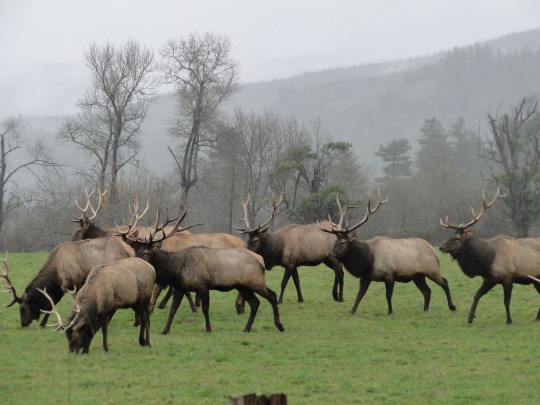
‧ ✦⠀𝐀 𝐇𝐄𝐑𝐃 𝐎𝐅 𝐑𝐎𝐎𝐒𝐄𝐕𝐄𝐋𝐓 𝐄𝐋𝐊⠀✦ ‧
6 notes
·
View notes
Text

Tuesday October 15/2024
A couple of Stellar Jays came to say hello while we were having our breakfast at Strathcona Park Lodge.
We drove to Gold River to explore more limestone caves. After driving on a gravel road for quite a while, and not finding the entrance to the caves, we decided to give up searching and drive to Telegraph Cove via the logging roads from Gold River to Woss. At least we were hugged by green forest along the way.
We had to stop and take pictures of a nice water fall and to let a herd of Roosevelt Elk crossing the road.
Our day got even more interesting when google sent us to a dead end road and we had to backtrack a few miles!
After driving for a couple of hours, on yet another gravel road with thousands of potholes, we got to the highway that led us to telegraph cove.
Of course the popular resort was closed for the winter season! But this allowed us to take pictures of every corner of this charming historic place, without any people in the way.
Then we drove to Port McNeill to catch a ferry to Alert Bay.
This island holds many beautiful and unique totem poles. I drove as slow as possible, so Simon’s could read the map to find each totem and take pictures of the interesting ones.
There were three indigenous grave yards that we visited: the historic one with faded grey totem poles and two newer ones with painted totem-like grave markers.
At 6:00 pm we were at the ferry terminal to catch another ferry to Sointula on Malcom Island.
We camped overnight on this island by the beach and prepared for an early morning hike.
2 notes
·
View notes
Video
Roosevelt Elk in a Grassy Meadow in Orick California by Mark Stevens Via Flickr: While at a pullout along Hwy 101 in Orick California with a view looking across a grassy meadow to a herd of Roosevelt Elk relaxing early afternoon. With this image, I decided to pull back on the focal length and include much of this large herd. I then cropped a portion of the foreground to have more of a balanced, white angle view.
#Azimuth 273#Blue Skies#California Hillsides#California and Oregon Road Trip#Cervus elaphus roosevelti#Day 8#DxO PhotoLab 5 Edited#Elk#Elk Herd#Evergreen Trees#Evergreens#Forest#Forest Landscape#Grassy Area#Grassy Field#Grassy Meadow#Hillsides#Hillsides Trees#Hillsides in Distance#Hillsides off in Distance#Homes#Landscape#Landscape - Scenery#Looking West#Meadows#Nature#Nikon D850#No People#North Humboldt Coast Range#Northern California Coast Range
2 notes
·
View notes
Text
Day 9 - America The Beautiful
We woke to a crisp, quiet Montana morning, stopping to really BE in the moment before starting what has become our new daily routine.
As we drove across the state, we realized no matter how many miles you drove, the landscape was seemed to be plains with small mountains off in the distance. We would occasionally cross the ever winding Yellowstone River. After about 5 hours, we finally reached our destination of Medora, ND. This quaint, little, old western town is steeped in history and sits 1 mile outside the entrance to Teddy Roosevelt National Park. It is easy to see the locals love their town and take pride in their artisan works, keeping it clean, and welcoming visitors. We had yet another lovely lunch in the Farmhouse Cafe, which is for sale by the way, just in case you wasn’t to move after seeing this post. 😊
This stop has been extraordinary and likely one of my top two stops. I am a bit of an animal enthusiast and this park is a place for me. Within a few minutes of being within the boundary of the park, we saw a healthy and sleek coyote, who may have been in search of a small snack or just passing through this little prairie dog town.
We decided to find our camp spot in Cottonwood Campground within the park before continuing on to the unexpected events that we had no idea would lie ahead. Our own little slice of heaven had a trail that led directly down to the river. Not a permanent trail, but one that was just wide enough for two legs to pass between the prairie grasses blowing ever so slightly in the fall breeze. Clearly, it was a trail used by both creature and man.
After taking a quick walk down to the river bed, which much like home, was much drier than usual and clearly in need of a soft, soaking rain, we hopped back in the car to start our driving loop tour of the park. I couldn’t believe my eyes when we saw horses, wild and free, grazing by the roadside. These gentle giants didn’t seemed disturbed at all by our presence or the small crowds that had gathered to stare in wonderment.
We continued our search for elk, only to find several prairie dog towns and more wild horse herds. So beautiful!
We opted to go on a small 1 mile dirt, off chute road, where I had read moose had been spotted. I was determined to see the moose that I learned will forever allude me on this trip. I even left the car to go up an animal trail to look over the ridge to what I expected to be a marshy meadow, but was instead a cliff like valley. So, I made my way back to the van noting the scent of urine and wild creature knowing it had to have been close by. As we went slightly further down the curved road and, I mean maybe a few hundred yards, we found ourselves in a bit of a pickle with none other than a herd of bison. It looked something like the opening of Law & Order, where the cast is all walking down the street in a side by side, straight line. (Short video attached). The herd just kept moving towards us on the road and Todd kept backing up the RV, unsure if one of these incredible beasts would charge the rental. The whole scene was incredible! In my opinion, it was all going very well until Lily decided they were too close and let out a loud bark, something she almost never does! Well that sent us into immediate shushing and the closest bison into a run! What a heart racing experience!
Knowing it was getting late, Dad was getting tired and realizing another long drive would be ahead tomorrow to get to Minnesota, we headed back to camp. Saw this one lonely fellow on our way back. He had clearly been injured and stitched back up, so hopefully he would find a new pack to join soon. Todd was very excited to get back to camp at dusk so he could see if any wildlife had decided to visit the river. How right he was! These 3 lovelies spent quite a bit of time mulling about on the opposite side of river from camp. Perfect end to another perfect day!









1 note
·
View note
Text
Day 19, Wed June 14: Sidney to Chadron Nebraska to Hot Springs and Needles Pky and Custer and Crazy Horse and Mt Rushmore and Rapid City, South Dakota. 457 km
Sidney is a small city of 6,400 in the NW corner of Nebrasa. It is located in one of the richest wheat growing areas of the state and is a major shipping centre for grain and oil products. I saw lots of trains in Sidney.
I begin my ride by heading north on 385 towards Bridgeport (pop 1,463), Alliance (pop 7,971), and the Nebraska National Forest. 20 miles short of the border, I pull into Chadron and spot Helen's Cafe. I decide to pull in and treat myself to some birthday pancakes. I end up hooking up with some locals, and when they find out it's my birthday, they buy me breakfast. They also recommend the bumbleberry pie at the Purple Pie House in Custer. Note to file.
I cross the border and encounter the Buffalo Gap National Grasslands, the second largest grassland in the USA. It's endless flat vista's of weaving grasses are a lull before I start to encounter the Black Hills on my way to Hot Springs, South Dakota (pop 3,485).
From Hot Springs, I begin my climb to Pringle (pop 107) in the heart of the Black Hills and the gateway to Hwy 87 and the Needles Pkwy., a must ride if you are on a motorcycle and in this area of South Dakota.
The Needles Highway is more than a 14-mile road—it’s a spectacular drive through pine and spruce forests, meadows surrounded by birch and aspen, and rugged granite mountains. The road’s name comes from the needlelike granite formations that seem to pierce the horizon along the highway.
I expected the scenery and winding roads in the Black Hills. What I didn't anticipate was the sight of numerous herds of grazing, wild buffalo.
I thought the Black Hills were a foothills to the Rockies or some other mountain range but in fact they are not. The Black Hills are an 8,426 sq mile isolated mountain range rising from the Great Plains of North America in western South Dakota and extending into Wyoming, United States. Black Elk Peak, which rises to 7,244 feet, is the range's highest summit.
Near the north end of the Pkwy, I turn west on US 16 to climb to Custer (pop 1,949 and over 5,000 feet) and find my bumbleberry pie. Another birthday treat - it's worth the trip.
From Custer, I head north on US 385 to Crazy Horse memorial. I didn't know quite what to expect, but it certainly wasn't this. Atop a 6,532' granite hilltop, they are carving a full statue of a horse mounted, Chief Crazy Horse. It is a huge undertaking that has now been in process off and on for 75 years. The final completion date is undetermined, but we are talking decades. Even now, partially completed, it almost puts Mt Rushmore to shame.
But not quite. I pull out onto US 16 and head for Mt Rushmore. The memorial there is carved into the northwest margin of the Black Elk Peak granite batholith at a height of 5,725'. Started in 1927 by Gutzon Borglum, it depicts busts of George Washington, Thomas Jefferson, Theodore Roosevelt, and Abraham Lincoln and took 14 years to complete. Lining the walk up to the viewing podium is the Avenue of Flags depicti g the flags and entry I to the Union of all the US States and Territories. It is an extremely impressive display, and I can only imagine e what it looks like all lit up at night.
But I have other plans. I get on my bike and head NE on US 16 to Rapid City. I need a cold beer, to work on my blog, and to plan another longtime ambition - my trip tomorrow to the South Dakota Badlands.
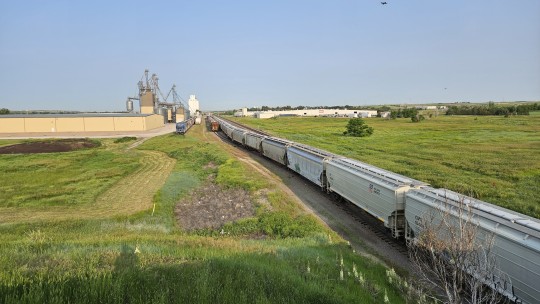
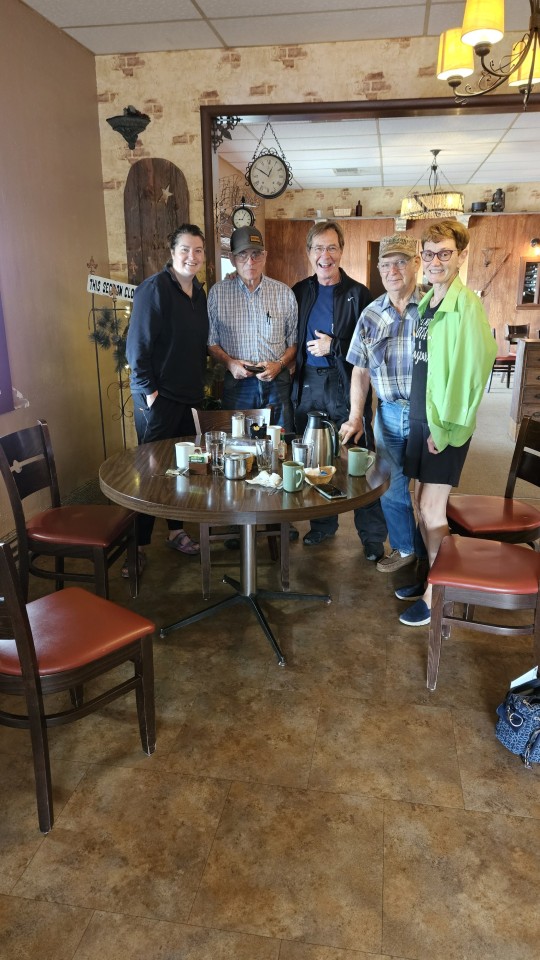

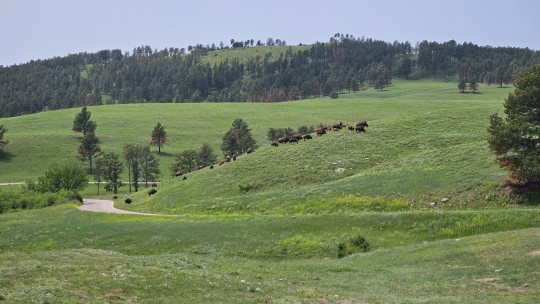


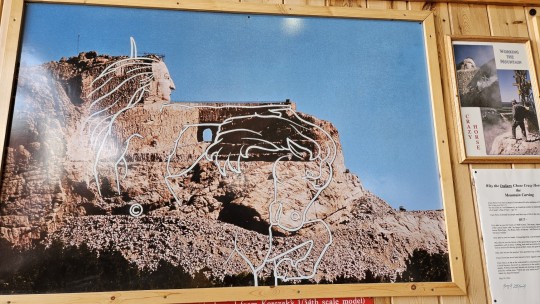

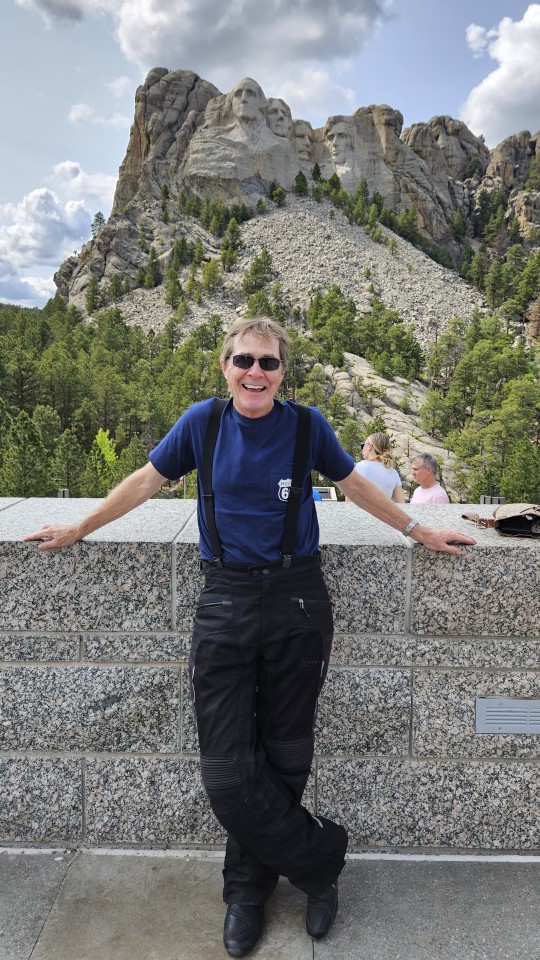

0 notes
Text

“Coastal Elk” - Roosevelt Elk Herd on Canon Beach, Oregon
#nature#outdoor photography#wildlife photography#beautiful wildlife#beautiful animals#Roosevelt elk#elk
48 notes
·
View notes
Text
On a recent July morning, as Stephanie Alexandre crossed the lane from her farmhouse to the office housed above the milking barn, fog hung low over the pastures and the air filled with the sounds of eagles and hawks. A group of dairy cows were on their way to a new allotment of tall grass. Down the road, past the grazing heifers, a large herd of wild Roosevelt elk roamed the land.
It was a typical day managing 1,800 cows and 2,500 acres on one of the four grass-based organic dairies that make up the Alexandre Family Farm, based in Crescent City, California, in the far northwest corner of the state. At a time when large dairy companies ranging from Danone to General Mills and Stonyfield Organic are investing in regenerative practices for their farmers in hopes of reducing their industry’s sizable carbon footprint, Alexandre is among a small number of dairies that have embraced regenerative agriculture, boosting soil health and biodiversity, without access to corporate support.
[Continue Reading]
17 notes
·
View notes
Text
If you like national parks in Fallout boy howdy do I got something for you
Fallout Yellowstone aka The Park
No bombs actually fell in the park but some radiation blew in
Tourists aren’t allowed to bring guns to the park pre war so when the bombs fell it was only the Park Rangers who were armed (and what was smuggled in). Over time guns became traded in but there is a reverence if they are tools and bullets are not to be wasted. Hunting and self defense only.
The Park Rangers when Yellowstone was founded were army members and they go back to their roots, protecting the people and the park. After things stabilized after the Great War many of them became studying the geothermal features and the new mutated animals that wandered into The Park.
Buffalo, elk, deer, wolves, moose, etc remained mostly unaffected by the war. The biggest mutations were buffalo getting much bigger and the antler growing animals having malformed antlers.
Buffalo are big enough to actually defend themselves against a deathclaw when they are in a herd. A single buffalo wouldn’t get away from a ‘Claw.
But that doesn’t mean the park is without mutated beasts. Radstags wander in and of course deathclaws are drawn to the thermal features.
Horses survived. The trial ride horses used in Roosevelt were carefully distributed around The Park so the rangers could still get around.
Old Faithful area is the biggest settlement with its fortified hotel and guest centers. The Jumbo Buffalo herds hang around the lower geyser basin and deathclaws in the area are an unusual occurrence; unless a hard winter passed and food for the animals is scarce.
Mammoth/Gardiner is the next biggest settlement. They were the first to be stable, being so close to the Montana border they were able to get supplies faster than the other settlements in The Park.
Raiders aren’t a problem in The Park. There is too high risk too little reward to mount an attack on a settlement in the middle of a remote, dangerous landscape filled with dangerous animals. But single outlaws and small gangs do hide out since it is a remote dangerous landscape filled with dangerous animals.
If y’all are dying to ask a question I’m dying to answer it!
937 notes
·
View notes
Text
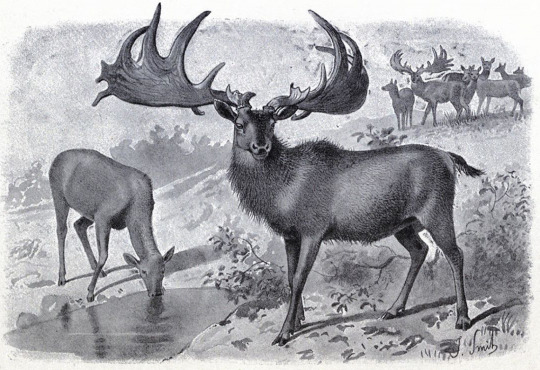
From heavyweight birds to nimble predators – to graceful prey and who were once deemed ecologically controversial landscapers, ever since the bombs dropped all those years ago, animals large and small felt the brunt end of the nuclear war. For decades or even centuries, many of the creatures who once roamed the pre-war USA are now lost to time. But some animals are defying the odds, recovering to healthy population levels long after being deemed lost causes. 200 years after the war, many creatures have bounced back, some surprisingly suffering little from the horrors of nuclear devastation. Others, descendants of the once proud wildlife who once roamed the world, now make their mark where their relatives once stood.
Fauna in the world of New America come in a variety of shapes and sizes and occupy wild areas throughout the world. After 200 years, many animals have started to once again return to their old habitats. Some animals have been domesticated by the inhabitants of the New America, and serve as pets, transportation or livestock. Other animals cluster together in the wild in packs, herds, and flocks and try and make a living in the new world. Like with most things, cycles never end. After humans, Deer and Elk populations in many parts of the states both exploded and diminished. While Radstag took the place of many of the larger elk and Deer species in the main Boston territories, many other deer species virtually remained unchanged. As a result, the wilds of Commonwealth are often teeming with deer. Docile creatures, they serve as food for much of the land’s more savage beasts. In addition to the common whitetail, which virtually remained unchanged in much of the US, other smaller deer species came into fruition following a long tedious evolutionary set path, each one designed to thrive within the new world.
Towards more northern territories in New America, Large species of Cervidae still roam the lands. Alces alces, or the Moose still holds title of the largest and heaviest original species in the deer family. However, unlike before in the older days where this animal would never have to fight for the title of largest Deer roaming the planet, the Moose now has competition from other Large Cervidae.
One such species is Megaloceros Ingentiaegidi
ingenti - large, remarkable (Latin) aegidi - shield (Latin)
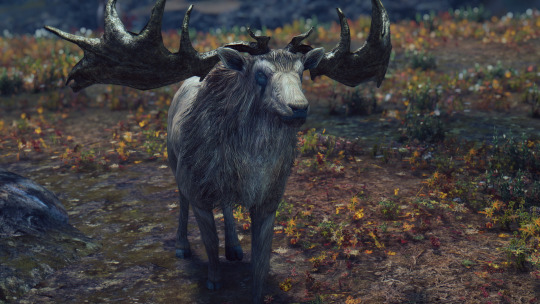
An absolute icon of prehistory come to life, this giant deer takes on the role of its name sake as one of the most impressive and largest species of Deer. Although comparable in size to moose (6 feet tall, 1,100 lbs), this animal is closer in relation, surprisingly to the Eurasian red deer, who were thought to be brought in to the America’s to fill in exotic game ranches, places where Hunters wouldn’t have to travel half-way across the world just to hunt certain species, or meat farms, as in modern times, western countries such as New Zealand and the United States had taken to importing and farming European red deer for venison.
The term Megaloceros was given to this deer species in regards to the highly noticeable and recognizable “Shield”, that Megaloceros, especially the more famous Megaloceros giganteus, aka the Irish Elk was known for sporting. Impressive antlers that instead of branching out and developing tines, have developed into large shovel-like (palmated) antlers with thick tines growing out from them. It is because of these antlers that this species were originally incorrectly thought to be derived from Moose, as Red Deer and other Elk species like Roosevelt and Rocky Mountain do not have Palmated shovel antlers, but large branching antlers which develop many tines during their life time.
Despite not being related, they are still a large animal when compared to other species of deer that now populate much of the New America landscape, being slightly dwarfed by Moose, (Alces alces) in terms of weight and height, while the moose is dwarfed by Altorell.
Huge deer, bigger than a domestic cow but with a graceful and elegant form perfect for bounding about the open environs where they are commonly found, the American Giant Elk, like most deer exhibit countershading, the belly being a much lighter color than the darkened back.
A shoulder hump stores fat reserves and also supports the animal’s huge antlers. With a span of up to twelve feet, these antlers are the largest of any deer by far; while females do not sport them, males use them to plow snow and expose edible plants, fend off predators, scratch the occasional back itch, and as weapons during the annual rut.
Enormous rutting stags crash their antlers together and shove to determine dominance, a sound that can be heard more than half a mile away. Most of the year these animals can be found in same-sex herds, grazing and browsing under the watchful eye of an appointed sentry. In the northern parts of their range they are often known too commingle with large herds of caribou.
Despite its keen senses, sharp hooves, and the males’ formidable antlers, they still have many natural predators, including wolves, big cats, bears, and wargs; humans too now hunt these creatures with regularity, some for subsistence and most for the trophy of a lifetime. Some humans also consider them sacred, representing bravery, fertility, endurance, and power. Living with so many dangerous predators has made them skittish and unpredictable, making them singularly unqualified for riding despite the many attempts.
Another Species of Cervidae one can stumble across is the Altorell
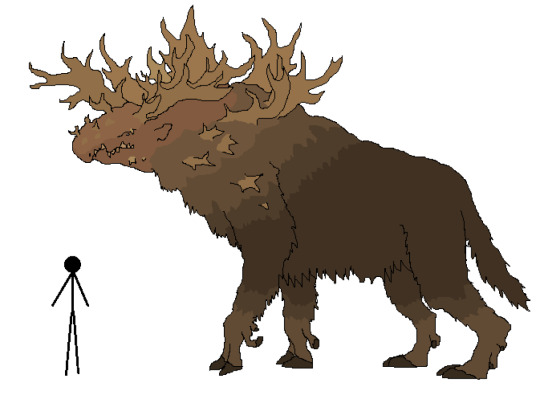
Described by many as a tangled mess of hair and muscle, with twisted antlers jutting out at seemingly random places on its upper body, it is a mutated member of the Cervine Family that branched off from their original pre-war counterparts, who, unsurprisingly given their tremendous size, happened to be moose!!
The result of a small isolated population of moose being tainted by the radioactive fallout from the onslaught of atomic warfare, it towers over even the most largest of the commonwealths largest fauna, with them being able to fend off large Deathclaw with ease. However, they are also horribly misunderstood creatures. Tales of their temper run rampant through the northern territories, but as it turns out, Altorell are not as aggressive as tall-tales dictate, with attacks against humans being the result of human’s harassing or otherwise giving the animal reasons to attack.
It is also thought that these hyped tales of aggression are also what gave rise to the idea that they are also bloodthirsty to their own kind. While it is true that males will often fight ferociously during breeding seasons with intruding males and deaths can occur during them, males do not actively go out of their way to kill members of their own kind as previously believed. And they are not as solitary as first believed either. Males are known to do what is described as “territory guarding” meaning that while it seems like they leave an area to roam somewhere else, they actually don’t.
And even in defense of their territory range, they are not all that aggressive towards other members of their kind. Rather than retaining a territory simply by fighting, which can cost the animal valuable energy or even result in serious injury or death, Altorell have a 3-stage process to territory guarding. Males often create "sign-posts" to advertise their territory. Sometimes these sign-posts are on the boundary thereby demarcating the territory, or, may be scattered throughout the territory. These communicate to other animals that the territory is occupied and may also communicate additional information such as the sex, reproductive status or dominance status of the territory-holder.
Sign-posts may communicate information by olfactory, auditory, or visual means, or a combination of these. If an intruder progresses further into the territory beyond the sign-posts and encounters the territory-holder, both animals may begin ritualized aggression toward each other. This is a series of stylized postures, vocalizations, displays, etc. which function to solve the territory dispute without actual fighting as this could injure either or both animals. Ritualized aggression often ends by one of the animals fleeing (generally the intruder). If this does not happen, the territory may be defended by actual fighting, although this is generally a last resort.
Because Altorell have what is known as Type-A territory- An 'all-purpose territory' in which all activities occur, e.g. courtship, mating, nesting and foraging-reports of territory size can be confused by a lack of distinction between home range and the defended territory. The size and shape of a territory can vary according to its purpose, season, the amount and quality of resources it contains, or the geography. The size is usually a compromise of resource needs, defense costs, predation pressure and reproductive needs. Younger animals do not need such large territories and as a result their range is smaller. Larger males have highly variable territory sizes, ranging from less than 4,000 hectares (9,900 acres) to almost to over 100,000 hectares (250,000 acres)
To put that range into perspective, The state of Rhode Island is 776,960 acres, or 1,214 square miles.
Females are also not that aggressive as well. Female Altorell without calves are mostly peaceful towards humans. However during their Breeding and Birthing Season, Altorell can become so aggressive and dangerous that many settlements will cordon off areas where they are known to roam, blocking roads and effectively banning entry on all lands for months at a time, until breeding season is done and calves are old enough to leave their mother.
Males have also been discovered staying close to birthing females, as their range can home at least about 3-5 females at a time, and Unlike Moose who only interact with their kind during breeding season and are normally solitary the rest of the year, Females and Male Altorell stay in close vicinity of each other for protection of the young, who when small can fall prey to larger creatures unlike the adults. If a female is in danger and requires aid she can call upon the neighboring females or call for her male, who will come to her rescue.
The only domesticated Altorell known to exist, goes by the name of Kheglen, and like most of his kind is protective against what he owns. But because he moves around a lot, his territory is not a set place. Instead it is the Caravan trailer which he associates with and what's in it, meaning the people living in it, and he'll protect it against anything he deems a threat. So he often roams freely around his "territory" getting rid of threats whenever they park the Caravan. And as it turns out that protection is even against things like passing BoS convoys, who he has learned can pose a danger to those he is protecting-because of this Kheglen has made it a habit of stalking the vicinity around the Caravans and even walking the roads attacking BoS convoys should they wander too close.
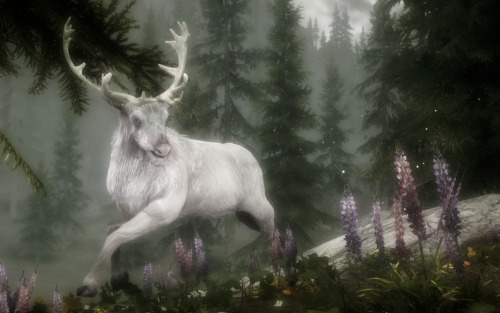
Knight Elk, also named "Moon-Stone Elk" or the Inakata Elk, are the fourth largest Elk species, crowned by an impressive pair of antlers that grow so large it is thought they never shed. Herbivores that live in cold climates, they are generally docile, though they have been known to attack when threatened. The distinguishable white hair and shaggy mane make this elk different to other elks in the region, and it is often said they possess a staggering majestic beauty that cannot be rivaled. With a herbivore diet includes grasses, leaves, bark and plants, their high-quality pelts have many uses, and their antlers are highly prized due to their unique branching similar to that of a European Red Deer. Shining and graceful with snowy coat, they are often a symbol of Strength, vitality, wisdom and cunning. As such it is often commonplace in some settlements in the north to give a Greystone charm carved in the animals likeness, to travelers in hopes of a swift journey. In other settlements, because of the stags symbol of fertility, Statues depicting the elk in various poses, are often given to expectant mothers in hopes that their children develop strong able and healthy. Many families also keep one in their home or on their doorstep for luck.
#Fallout#Fallout 4#Fallout AU#Fallout World Building#What is sought is most often found if it is truly sought: World Information
11 notes
·
View notes
Text
I love that while watching the nay geo American nation parks doc I see the elk herd that I know well.
I’m just sitting here and suddenly it’s like “my elk!” Like seeing a friend on tv
The Roosevelt elk herd like to eat around in town in the winter
#this was december#the dogs go nuts every time#yes thats an old schoolbus#national parks#national geographic#nat geo#olympic national park#washington state us#pnw#elk
19 notes
·
View notes
Text
Not the best pics, but...

One evening, a couple of weeks ago on the Skokomish River...

...I caught a herd of Roosevelt Elk going for their evening graze. If you’ve never seen them in person, take my word for it, they are LARGE animals.Their high-pitched chips are in surprising contrast to their size.

Watching them reminded me that I’m the visitor in their world. Felt quite humbled.
#elk#roosevelt elk#wildlife#humbled#like a motherfucker#skokomish river#olympic peninsula#olympic national park#washington state#pnw#pnwonderland#upperleftusa
62 notes
·
View notes
Photo

I became a little lost while hiking yesterday but as good luck would have it, I came across this herd of elk. You can see the antlers are just starting to come in on this guy. Roosevelt elk are the third largest land mammal in North America. They are the largest of the 4 remaining species of elk in North America. This particular species of elk are named after President Theodore Roosevelt. ...and yes, they were scary huge. #elk #rooseveltelk #elkofinstagram #nature #wildlife #wildlifephotography #wildlife_captures #wildlifeplanet #wildlife_perfection #wildlife_seekers #wildlife_photography #wildlifeofinstagram #natgeowild #natgeoyourshot #vancouverisland #vancouverisawesome #vancouverislandguide #discovervancouverisland #discovercanada #explorevancouverisland #explorecanada #vancouverislandbc (at Vancouver Island, Canada) https://www.instagram.com/p/B_iE0ovneM_/?igshid=1dr7de1j241yt
#elk#rooseveltelk#elkofinstagram#nature#wildlife#wildlifephotography#wildlife_captures#wildlifeplanet#wildlife_perfection#wildlife_seekers#wildlife_photography#wildlifeofinstagram#natgeowild#natgeoyourshot#vancouverisland#vancouverisawesome#vancouverislandguide#discovervancouverisland#discovercanada#explorevancouverisland#explorecanada#vancouverislandbc
2 notes
·
View notes
Video
A Herd of Roosevelt Elk Hanging out One Day in Northern California by Mark Stevens Via Flickr: While at a pullout along Hwy 101 in Orick California with a view looking across a grassy meadow to a herd of Roosevelt Elk relaxing early afternoon. With this image, I decided to zoom in with the focal length and center on two of the elk.
#Azimuth 273#Blue Skies#California Hillsides#California and Oregon Road Trip#Cervus elaphus roosevelti#Day 8#DxO PhotoLab 5 Edited#Elk#Elk Herd#Evergreen Trees#Evergreens#Forest#Forest Landscape#Grassy Area#Grassy Field#Grassy Meadow#Hillsides#Hillsides Trees#Hillsides in Distance#Hillsides off in Distance#Homes#Landscape#Landscape - Scenery#Looking West#Meadows#Nature#Nikon D850#No People#North Humboldt Coast Range#Northern California Coast Range
2 notes
·
View notes
Video
vimeo
Original caption:
MTJP | Redwood is the culmination of several weeks spent exploring Redwood National and State Parks. Redwood National and State Parks in Northern California are home to the tallest trees in the world, the mighty Redwood, which can reach staggering heights of over 360ft and weigh more than 500 tons. These parks feature magical forests, miles of spectacular beaches, stunning overlooks, and the largest herd of Roosevelt elk on the planet. This film was shot entirely in 4K.
To learn more about the More Than Just Parks Project please visit our website: morethanjustparks.com/
To learn more about the making of this video please visit: morethanjustparks.com/redwood To learn more about Redwood National & State Parks visit: nps.gov/redw/
76 notes
·
View notes
Photo

Went for a walk in the drizzle at Ft. Stevens State Park. Got to see this nice herd of Roosevelt #elk! #wildlife #megafauna
4 notes
·
View notes
Photo

To epic campsites. We had a lot of amazing campsites on this project. We camped next to massive glaciers, on small islands, by remote rivers, in verdant rainforests, and on sandy beaches (to name a few). We camped in grizzly bear country, mountain lion country, near migrating birds, next to salmon spawning upriver, and by herds of Roosevelt Elk. We camped in sunshine, snow, rain, hail, and just about every kind of weather you can encounter. We are campers at heart and this project provided us with some insanely cool camping opportunities. But I think both @istefpayne and I would agree that the one pictured here was one of our favorite on the project, as well as one of our favorites of all time. This view was right behind our campsite in Canyonlands National Park. It’s where we had coffee in the morning, and where we would sit with a flask of whiskey at night to watch the sunset. It was, simply put, breathtaking. I bet you want to know which campsite this is, right? Well, we detail the exact location in our book (link in bio). 😜 · @CanyonlandsNPS (the 31st U.S. National Park) in #Utah was established by the @NationalParkService on September 12, 1964. · Stay tuned as @istefpayne and I count down all 60 of the U.S. national parks, sharing previously untold stories and/or photos from our epic road trip to visit all the parks during the 2016 centennial of the park service #onassignment for @natgeo and @fujifilm_northamerica. · While we are counting down, you can get your hands on a copy of our gorgeous 240-page National Park coffee table book for 25% off! Just go to the link in my bio and order a copy through Amazon. No coupon code needed, discount already applied! Price is as marked. (at Canyonlands National Park) https://www.instagram.com/p/BrGhg08hj2p/?utm_source=ig_tumblr_share&igshid=dpzvf2jc0ecd
12 notes
·
View notes